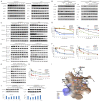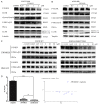A novel multi-target inhibitor harboring selectivity of inhibiting EGFR T790M sparing wild-type EGFR
- PMID: 28979811
- PMCID: PMC5622223
A novel multi-target inhibitor harboring selectivity of inhibiting EGFR T790M sparing wild-type EGFR
Abstract
Non-Small Cell Lung Cancer (NSCLC) is driven by a variety of deregulated kinases and the development of multi-target inhibitor for multiple signaling pathways or multiple steps is required. Here, we reported that ZWM026, an indolocarbazoles analogue, derived from mangrove in coastal marine wetland, exhibited selectivity and reversibility against T790M mutant over wild-type EGFR in naturally occurring NSCLC cells and constructed NIH-3T3 cells. It simultaneously inhibited activities of HER2, HER3, HER4 and RET but was different from current multi-target kinase inhibitors. There was no activity in protein kinase C (PKC) family which is generally recognized as molecule target of indolocarbazoles. ZWM026 had more potent activities against gefitinib sensitizing, non-sensitizing and rare EGFR mutant NSCLC cells and constructed NIH-3T3 cells. ZWM026 induced apoptosis and exerted a synergistic effect by combining with cisplatin in NCI-H1975 cells. In summary, we identified a novel reversible multi-target inhibitor which could serve as a promising lead compound of drug development for NSCLC.
Keywords: EGFR T790M; NSCLC; ZWM026; multi-target inhibitor.
Conflict of interest statement
None.
Figures





Similar articles
-
Synthesis and biological evaluation of morpholine-substituted diphenylpyrimidine derivatives (Mor-DPPYs) as potent EGFR T790M inhibitors with improved activity toward the gefitinib-resistant non-small cell lung cancers (NSCLC).Eur J Med Chem. 2017 Jun 16;133:329-339. doi: 10.1016/j.ejmech.2017.03.083. Epub 2017 Apr 2. Eur J Med Chem. 2017. PMID: 28395219
-
Staurosporine scaffold-based rational discovery of the wild-type sparing reversible inhibitors of EGFR T790M gatekeeper mutant in lung cancer with analog-sensitive kinase technology.J Mol Recognit. 2017 Apr;30(4). doi: 10.1002/jmr.2590. Epub 2016 Nov 28. J Mol Recognit. 2017. PMID: 27891677
-
Oxopyrido[2,3-d]pyrimidines as Covalent L858R/T790M Mutant Selective Epidermal Growth Factor Receptor (EGFR) Inhibitors.ACS Med Chem Lett. 2015 Jul 27;6(9):987-92. doi: 10.1021/acsmedchemlett.5b00193. eCollection 2015 Sep 10. ACS Med Chem Lett. 2015. PMID: 26396685 Free PMC article.
-
Fighting cancer drug resistance: Opportunities and challenges for mutation-specific EGFR inhibitors.Drug Resist Updat. 2015 May;20:12-28. doi: 10.1016/j.drup.2015.05.002. Epub 2015 May 12. Drug Resist Updat. 2015. PMID: 26021435 Review.
-
Next-generation EGFR/HER tyrosine kinase inhibitors for the treatment of patients with non-small-cell lung cancer harboring EGFR mutations: a review of the evidence.Onco Targets Ther. 2016 Sep 6;9:5461-73. doi: 10.2147/OTT.S94745. eCollection 2016. Onco Targets Ther. 2016. PMID: 27660463 Free PMC article. Review.
Cited by
-
FGFR leads to sustained activation of STAT3 to mediate resistance to EGFR-TKIs treatment.Invest New Drugs. 2021 Oct;39(5):1201-1212. doi: 10.1007/s10637-021-01061-1. Epub 2021 Apr 7. Invest New Drugs. 2021. PMID: 33829354
-
Molecular Targets of Active Anticancer Compounds Derived from Marine Sources.Mar Drugs. 2018 May 22;16(5):175. doi: 10.3390/md16050175. Mar Drugs. 2018. PMID: 29786660 Free PMC article. Review.
-
Synthetic and Naturally Occurring Heterocyclic Anticancer Compounds with Multiple Biological Targets.Molecules. 2021 Nov 25;26(23):7134. doi: 10.3390/molecules26237134. Molecules. 2021. PMID: 34885716 Free PMC article. Review.
References
-
- Yang J, Lin J, Liu T, Chen T, Pan S, Huang W, Li S. Analysis of lncRNA expression profiles in non-small cell lung cancers (NSCLC) and their clinical subtypes. Lung Cancer. 2014;85:110–115. - PubMed
-
- Doebele RC, Oton AB, Peled N, Camidge DR, Bunn PA Jr. New strategies to overcome limitations of reversible EGFR tyrosine kinase inhibitor therapy in non-small cell lung cancer. Lung Cancer. 2010;69:1–12. - PubMed
-
- Cross DA, Ashton SE, Ghiorghiu S, Eberlein C, Nebhan CA, Spitzler PJ, Orme JP, Finlay MR, Ward RA, Mellor MJ, Hughes G, Rahi A, Jacobs VN, Red Brewer M, Ichihara E, Sun J, Jin H, Ballard P, Al-Kadhimi K, Rowlinson R, Klinowska T, Richmond GH, Cantarini M, Kim DW, Ranson MR, Pao W. AZD9291, an irreversible EGFR TKI, overcomes T790M-mediated resistance to EGFR inhibitorsin lung cancer. Cancer Discov. 2014;4:1046–1061. - PMC - PubMed
LinkOut - more resources
Full Text Sources
Research Materials
Miscellaneous
